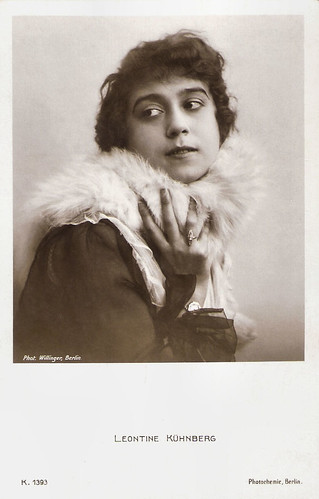
German postcard by Photochemie, Berlin, no. K. 1393. Photo: Willinger, Berlin.
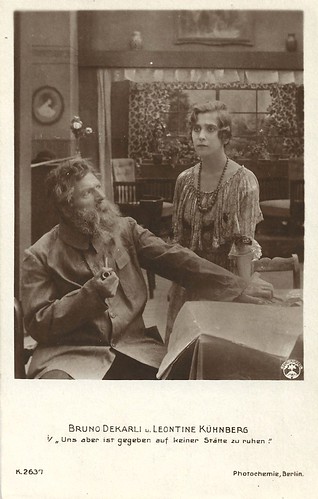
German postcard by Photochemie, Berlin, no. K. 2637. Photo: Eichberg-Film. The film title Uns aber ist gegeben auf keiner Stätte zu ruhen/But to us it is given to rest on no place is absent on IMDb and Filmportal. From the six films that Richard Eichberg directed with Leontine Kühnberg in 1918, all for his own company Eichberg-Film, a probable option is Im Zeichen der Schuld/Under the sign of guilt (Richard Eichberg, 1918), aka Aus dem Leben eines Vorbestraften/From the life of a convicted man. Filmportal.de lists this as the only film in which Bruno Decarli and Kühnberg played together in a film by Eichberg-Film. The plot deals with a man (Decarli) who, convicted of forging his boss's name, kills the bank director and assumes his identity. However, the Early German Film Database does list the film Uns aber ist gegeben, auf keiner Stätte zu ruhen as a separate film (1918), directed by Eichberg, and starring Decarli and Kühnberg. So perhaps, this is a separate film after all.
An impossible menage à trois
Leontine Kühnberg was born Leontine Chimberg in 1889 in Berlin. She was the daughter of the Jewish merchant Emil Chimberg and his wife Heni, née Lastu. Leontine can be traced as a theatre actress from 1908. For a time she belonged to the ensemble of Max Reinhardt's Deutsches Theater.
Shortly before the outbreak of the First World War, she began to make films, first under the direction of Harry Piel in Der schwarze Pierrot/The Black Pierrot (1913) with Ludwig Trautmann. In 1914 she started at PAGU / Union, led by Paul Davidson. Her participation in two Hermann Sudermann adaptations, Die Geschichte der stillen Mühle/The story of the silent mill (Richard Oswald, 1914) and Der Katzensteg/The catwalk (Max Mack, 1915), brought her recognition.
The former film dealt with an impossible menage à trois, also with Alfred Abel and Robert Valberg, while the latter was set in Napoleonic times and dealt first with a father-son conflict in which a maiden was forced to help the father and the French enemy, and later on the son, despite being a Prussian free fighter, defending the woman at all costs. Ferdinand Bonn, who later on often acted with her, already had supporting parts in these two films.
Kühnberg continued at PAGU in films such as Pension Lampel (Max Mack, 1915) and So rächt sich die Sonne/This is how the sun takes revenge (William Wauer, 1915) based on a script by Richard Oswald. Apart from PAGU she also acted in the mid-1910s in Otto Rippert's Der grüne Mann von Amsterdam/The green man from Amsterdam (1916) with Erich Kaiser-Titz, Harry Piel's Das lebende Rätsel/The living enigma (1915) with Ludwig Trautmann.
She also acted in Richard Oswald's films Seine letzte Maske/His last mask (1916), Zirkusblut/Circus blood (1916), Des Goldes Fluch/The Curse of Gold (1917), and in particular, in the lost film Es werde Licht/Let There Be Light, I (1917), protesting the anti-abortion-law and warning against syphilis. In all these films she co-starred with Bernd Aldor. According to IMDb, Kühnberg also acted in two Hungarian films: Az ezüst kecske/The Medic (Michael Curtiz, 1916) with Victor Varconi, and A Világ csak hangulat/The World is just a mood (Eugen Illés, 1917). With Eugen Illés she also would do various German films too.

Spanish collector's card (cromo) by Chocolat Imperial, no. 1 of 6. Photo: Distr. J. Verdaguer, Barcelona / Eichberg-Film. Leontine Kühnberg and Ferdinand Bonn in Die goldene Mumie/The Golden Mummy (Richard Eichberg, 1918).
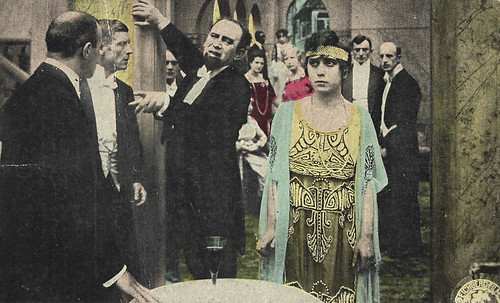
Spanish collector's card (cromo) by Chocolat Imperial, no. 3 of 6. Photo: Distr. J. Verdaguer, Barcelona / Eichberg-Film. Leontine Kühnberg and Ferdinand Bonn in Die goldene Mumie (Richard Eichberg, 1918).
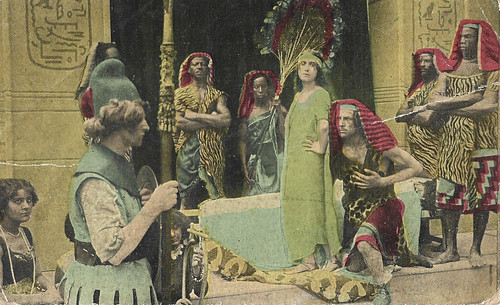
Spanish collector's card (cromo) by Chocolat Imperial, no. 4 of 6. Photo: Distr. J. Verdaguer, Barcelona / Eichberg-Film. Leontine Kühnberg and Ferdinand Bonn in Die goldene Mumie (Richard Eichberg, 1918).
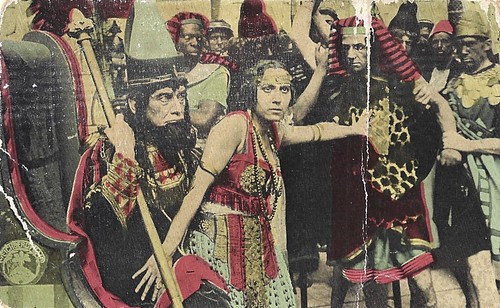
Spanish collector's card (cromo) by Chocolat Imperial, no. 5 of 6. Photo: Distr. J. Verdaguer, Barcelona / Eichberg-Film. Leontine Kühnberg and Ferdinand Bonn in Die goldene Mumie (Richard Eichberg, 1918).
A Daughter of Her People
In 1918, after a few films at Duskes and Neutral-Film, Leontine Kühnberg stepped over to Eichberg-Film, where she did seven films from 1918-1919 under the direction of Richard Eichberg. These included Die goldene Mumie/The Golden Mummy (1918), also with Ferdinand Bonn, Die letzte Liebesnacht der Inge Tolmein/Inge Tolmein's Last Night of Love (1918), with Karl Falkenberg, and Die Tragödie der Manja Orsan/The Tragedy of Manja Orsan (1919), in which she had the title role opposite Charles Willy Kaiser.
She then moved to Neutral-Film for a few films under the direction of Eugen Illés, e.g. Die silberne Fessel/The silver shackle (1919-20) and Moral (1920), often acting opposite Ernst Rückert.
Her last films were for the company Neos-Film, among which Judith Trachtenberg (Henrik Galeen, 1920), about a young Jewish woman who cannot choose between her Jewish family and roots and her non-Jewish lover, a count (Paul Otto). Moreover, she is pregnant with her husband-to-be. In the end, she commits suicide. In 1932 an American remake was released as A Daughter of Her People. According to IMDb, the film was re-edited and re-released with a new framing story as A Daughter of Her People (Henrik Galeen, George Roland, 1932)
At the beginning of 1921, Leontine Kühberg got married to the businessman and film producer Ludwig Schwarz in Vienna, for whose Neos-Film GmbH she had appeared in leading roles three times before. She withdrew from the film sets. In the following years, the couple lived in the Berlin districts of Wilmersdorf and Charlottenburg, where Ludwig Schwarz ran a large hosiery factory. In 1930, Leontine Kühnberg was the owner of the short-lived publishing house Buchkultur, which she ran together with her husband.
No definite information is currently available about her later fate. In 1970, Leontine Kühnberg was declared dead at the Schöneberg District Court, with 31 December 1945 as the official date of death. Her last place of residence was presumably Warsaw so it must be assumed that the actress, who was considered a "full Jewess" according to Nazi racial doctrine, died violently - possibly in connection with the Warsaw Ghetto. Her husband had already been declared dead in 1962. IMDb writes she already died in 1924 but this is a mistake. The writer Ernst Birnbaum was a cousin of Leontine Kühnberg.
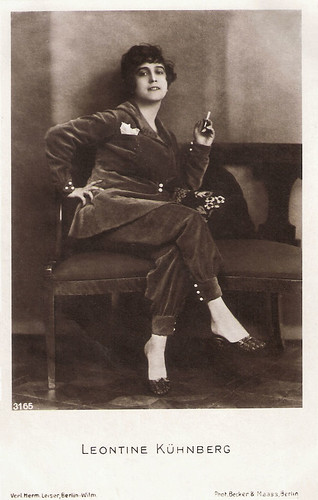
German postcard by Verlag Hermann Leiser, Berlin-Wilm., no. 3165. Photo: Becker & Maass, Berlin.

German postcard by Verlag Hermann Leiser, Berlin-Wilm., no. 3166. Photo: Becker & Maass, Berlin.
Sources: Filmportal, Wikipedia (German) and IMDb.
No comments:
Post a Comment